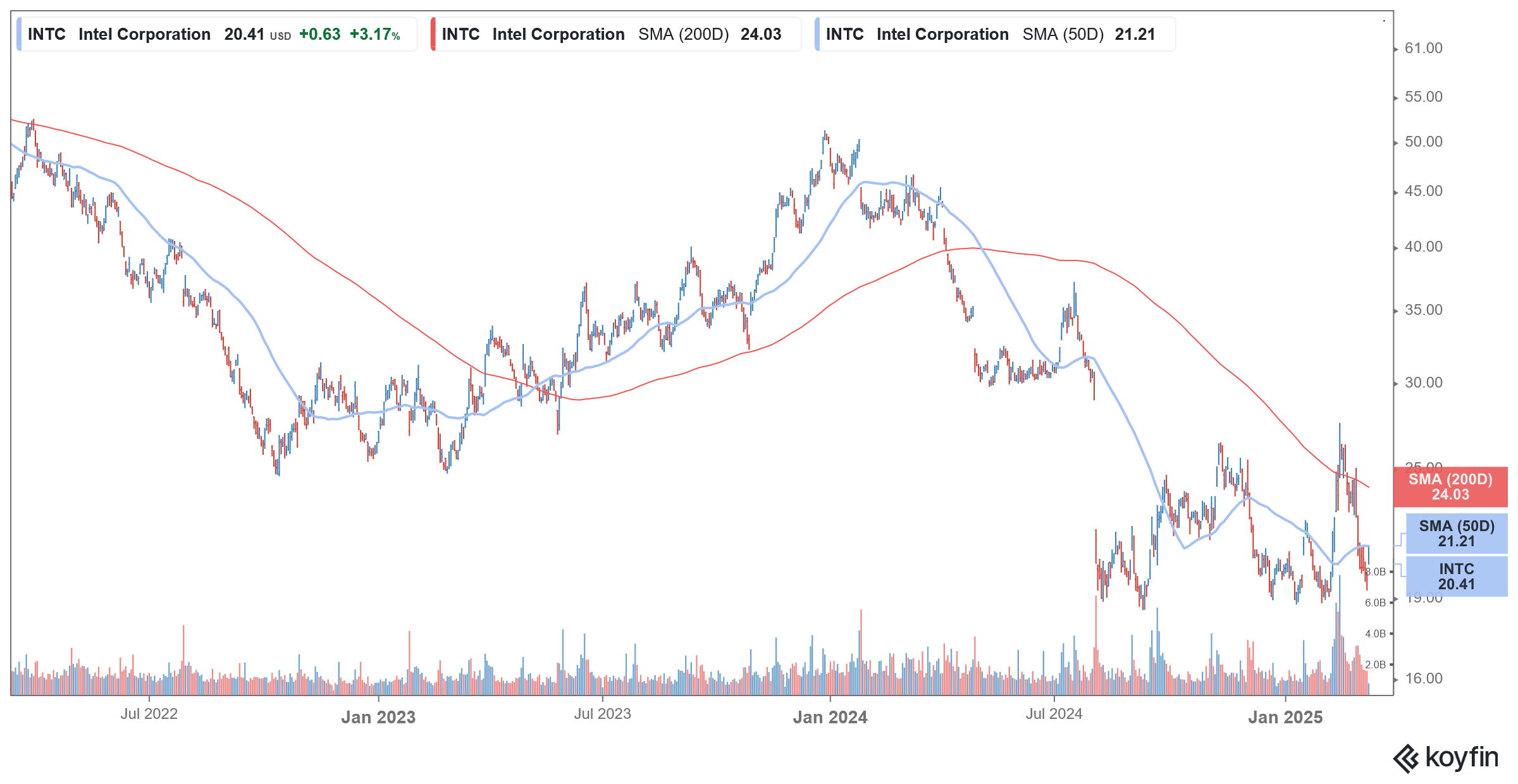INTC Stock Rises on Reports TSMC Pitched Intel Foundry JV to Other Chip Companies
Please note that we are not authorised to provide any investment advice. The content on this page is for information purposes only.
Intel stock (NYSE: INTC) is trading higher in early US price action today amid reports that TSMC approached US-based semiconductor companies to take a stake in a joint venture (JV) to operate Intel’s foundries.
Earlier this year also, there were reports that Intel which is the biggest beneficiary of the CHIPS Act might partner with TSMC. Notably, Taiwan-based TSMC is the world’s biggest foundry and makes chips for multiple companies including Nvidia. The company’s revenues have skyrocketed over the last two years thanks to the growing demand for AI chips.
Intel has been looking at strategic alternatives and, among others, might consider selling its foundry business, which posted an operating loss of $13.4 billion last year. While Intel was previously expecting to become a key global player in the foundry business, the segment has been losing money, and if anything, the losses have only widened over the last couple of years. Last year, Intel posted a net loss of $18.8 billion, which was its first annual loss since 1986.
TSMC Pitched a JV in Intel Foundry Business
According to a Reuters report, Intel pitched a JV in Intel’s foundry business to Qualcomm, Broadcom, Nvidia, and Advanced Micro Devices. TSMC is reportedly looking to run the operations of Intel’s foundry division but wants to limit its stake to 50%.
Notably, earlier this month, TSMC announced a $100 billion investment in the US to build five new factories. Reportedly, the Trump administration requested TSMC to help in turning around Intel. While Intel was once the world’s biggest chip company, it lost out to new rivals. Moreover, chip manufacturing shifted to Asia, especially Taiwan which is now home to the some of the biggest chip makers.
Intel Lost Out to Competition
Founded in 1968, Intel has a glorious past. Among others, it developed the metal-oxide semiconductor and the world’s first programmable microprocessor. It released the dynamic random-access memory (DRAM), which established semiconductors as the new standard for the industry. The company’s hardware was used in Altair 8800, which was among the world’s first personal computers. By 1992, it became the largest semiconductor manufacturer in the US, and four years later, it was featured among the top 10 most admired companies in the US.
While Intel’s fortunes have nosedived, other chip companies have raced ahead. In 2023, Nvidia’s revenues surpassed that of Intel. As for the valuation, the lesser said the better as while Nvidia’s market cap topped $3 trillion last year and it briefly became the world’s biggest company, Intel’s market cap has slumped below $100 billion. For context, Intel’s foundry business had its property plant and equipment valued at a book value of over $100 billion at the end of 2024.
What Went Wrong with INTC?
A lot went wrong with INTC over the last two decades. Perhaps, most importantly, it misread the smartphone market and turned down the offer to supply processors for the Apple iPhone. The company believed that Apple might not be able to sell enough of these, and it was a tiny market to bet on.
As things turn out, global smartphone sales now far exceed PCs and last year global smartphone shipments were 1.22 billion which is almost five times of PC shipments.
Intel was quite slow with innovation, and AMD gradually took its market share in the PC market. Apple, too, stopped using Intel chips for its Mac and instead pivoted to its own chips.
Intel’s woes are far from over and Nvidia, AMD, and Qualcomm are looking to further eat its PC market share with Arm-based semiconductors. Intel is still working with its x86 technology that it created in 1981.
More recently, Intel seems to have lost out on the race in artificial intelligence (AI) chips even as rivals, especially Nvidia, are printing money selling AI chips.
INTC’s Turnaround Did Not Go As Planned
In 2021, Intel brought back its previous CEO Pat Gelsinger amid the company’s sagging fortunes. Gelsinger embarked on what he termed IDM 2.0 strategy which has two key pillars. Firstly, it worked on innovation in the chip designing business to effectively compete with the likes of AMD and Nvidia. The second leg of turnaround strategy was pivoting the company to the foundry business where Intel started building chips for other companies. Finally, Intel started unlocking value in its subsidiaries and successfully listed Mobileye.
However, in December, Gelsinger was abruptly removed from his position amid the continued fall in Intel stock under his leadership. Intel has been working without a permanent CEO since then and is currently functioning under two interim co-CEOs.
Multiple Companies Are Reportedly Interested in Intel
Last year, there were reports that Qualcomm was looking to acquire Intel. While both Intel and Qualcomm are in the chip industry and compete in many markets, especially the PC industry, their business models differ. Qualcomm, like Nvidia, is a chip-designing company and relies upon other companies to produce its chips.
However, any Intel merger might face regulatory heat. Previously, Chinese regulators blocked Intel’s bid to acquire Tower Semiconductor and Qualcomm’s proposed acquisition of NXP Semiconductor. Other regulators, too, have been wary of big mergers in the chip space, and in 2018, then-President Donald Trump blocked Broadcom from acquiring Qualcomm over national security concerns. More recently, Nvidia and Arm called off their merger amid regulatory heat in Asia, Europe, and the US. Arm, which is backed by Japan’s SoftBank, eventually went for an IPO.
All said, reports of Intel being acquired have popped up quite often over the last six months and among other Arm Holdings was also said to have considered buying the company’s Products segment. So far, none of these have materialized and it remains to be seen whether Intel which was once the dominant chipmaker globally is acquired – either in whole or in parts.






